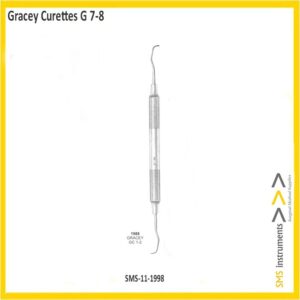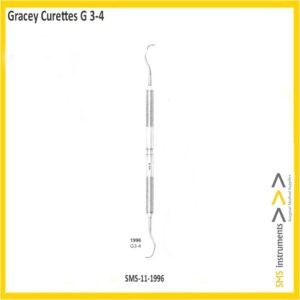Description
Gracey Curettes GC 3-4
Dental Instruments
SMS Instrument Gracey Periodontal Curette is a double-ended dental curette used to scale and remove deposits from posterior teeth. The blade variations are specific to the particular posterior tooth surface being cleaned. This product is the size #3 / #4 curette. It has two sharp, angled, hook style tips and a round Hallow handle.
| Surname | Gracey Curettes |
| Tip Configuration | Sharp Hook Style |
| Size / Model / Figure | 3-4 |
| curvature | Angled |
| Handle | Round Hallow Double Ended |
| Finishing | Mirror Polish Finishing |
| Instrument Type | Dental Gracey Curettes |
| Material | Stainless Steel |
| Disposable or Reusable | Reusable |
| Rusting Prevention | Passivation Processed |
| Cleaning | Ultrasonic Cleaned |
| Sterile or Non-Sterile | Non-Sterile |
| Latex or Latex-Free | Latex-Free |
| Test Performed | Boil, Shape & Performance Test |
| Grade | Premium OR-Grade |
| Packing | Individually Packed in SMS Brand printed Poly-sleeve |
Gracey Curettes
Dental Gracey blade designed in offset from the terminal shank at 70 degree. This creates one cutting edge which is referred to as the lower edge. The blade of a Gracey Curettes is correctly adapted when the lower cutting edge is against the tooth and the terminal shank is parallel to the tooth surface being scaled. Apply lateral pressure against the tooth (root) and pull upwards, maintaining the parallel shank.
Gracey Curettes are available in:-
Standard
Rigid
After five
Mini five
Standard Gracey curettes
Gracey curettes are area specific to allow for deep scaling, root planning and periodontal debridement. The offset blade provides a perfect working angulation for the tooth surface. Gracey Curettes are used in a set to completely scale the detition.
Rigid Gracey Curettes
All Gracey designed are available with a wider taper-Rigid shank. The rigid shank may be preferred for heavier calculus removal. Although the shank is wider, the blade with is the same as the standard Gracey.
After Five Gracey Curettes
Designed for instrument in deeper periodontal pockets. The terminal shank is elongated 3mm to provide better clearance around crowns, and superior access to root contours and pockets 5mm or more in depth. Blade thinned by 10% to ease gingival insertion and reduce tissue distention. The change in the location of the shank bend permits deeper insertion into periodontal pockets. The thinned blade allows for easier insertion.
Mini Five Gracey Curettes
Designed with the same elongated terminal shank and thinned blades as the after five Gracey Curettes. 50% shorter blade for access to smaller roots, narrow pockets, furcations, and developmental grooves. Mini five curettes reaching into deep pocket on a narrow root.
Features & Benefits
- Blade with 20% thinner than Mini-Five Gracey Curette
- Perfect for accessing furcations and root depressions (concavities)
- Elongated terminal and functional shanks allow increased reach and access into deep pockets.
- Area-Specific designs offer exact adaptation and control
- EverEdge technology provides a superior scalling experience.
- Super sharp blades that last longer
- Ergonomically engineered for a comfortable, healthy, scalling experience.
Types of Curettes
A Curette is a type of scaler that is designed for moderate calculus removal on supragingival and subgingival surfaces.
- Universal
Used in any area
Both Cutting edge used
Curved in one plane
Face of blade at 90 degree to shank
- Area Specific (Gracey)
Used in specific area
One cutting edge used
Curved in two plane
OfSet blade
All Curettes share the same common elements:
- Round back
- Rounded toe
- Semi-Circular cross section
Universal Curette
Universal Curette are designed for easy adaptation on all tooth surfaces (thus the name universal) . The blade of a universal curette has a round toe and back, and two cutting edge for scaling. Making it an efficient design for scaling the entire mouth. The blade is correctly adapted when the toe is directed interproximally and the terminal shank is parallel to the tooth to remove deposits the cutting edge is applied to the tooth surface and the facial surface of the blade is tilted toward the tooth to achieve a 70-85 degree angle between the tooth and the blade. Apply lateral pressure against the tooth and pull upward while maintaining contact with the tooth.
Anterior universal
- To scale the facial surfaces, place the toe of the blade toward the proximal surface with the handle parallel to the tooth.
- Apply strokes to remove deposits from the midline of the tooth to the proximal surface
- Work from canine to canine
- Switch working ends and repeat for surfaces
- Repeat all of the above for the lingual surfaces.
Posterior universal
- Begin at the distal line angle of the most posterior
- Direct the toe of the blade toward the distal with the terminal shank angled slightly toward the tooth
- Apply strokes from the line angle to the contact area
- Next, turn the toe toward the mesial to scale the buccal and mesial surfaces.
- Switch ends and repeat from the lingual aspect.









